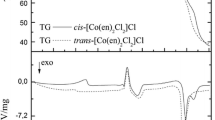Abstract
A quick method for determination of equilibrium temperature of high temperature reactions, which is inexpensive and suitable for small industrial laboratories, is reported. Reaction of high temperature dissociation of calcium carbonate is used as example for quick method application. The method is based on calorimetric measurement, Hess Law, and thermodynamic calculations. The calibrated calorimeter is used to determine enthalpy change for reactions CaCO3(s) + HCl(l), Ca(s) + 2HCl(l), and CaO(s) + 2HCl(l). By application of Hess’s energy cycle, enthalpies of formation of calcium carbonate and calcium oxide were determined. Acquired results were used to calculate enthalpy change for carbonate dissociation reaction. Calculated enthalpy change value was used for free energy change in dependence of temperature and also for equilibrium constant in dependence of temperature calculation using equations derived from basic thermodynamic equations. Using this method, equilibrium temperature for calcium carbonate dissociation reaction is found to be equal to 1154.14 K, which confirms accuracy of the method.




Similar content being viewed by others
References
Boynton RS. Chemistry and technology of lime and limestone. 2nd ed. New York: Wiley; 1980.
Johnston J. Thermal dissociation of calcium carbonate. J Am Chem Soc. 1910;32:938.
Smyth FH, Adams H. The system calcium oxide–carbon dioxide. J Am Chem Soc. 1923;45(5):1167–84.
Tamaru S, Siomi K, Adati M. Neubestimmung thermischer Dissoziationgleichgewichte von anorganischen Verbindungen. Z Phys Chem Abt A. 1931;157:447–67.
Southard JC, Royster PH. The thermal dissociation of calcium carbonate. J Phys Chem. 1936;40(4):435–8.
L’vov BV, Polzik LK, Ugolkov VL. Decomposition kinetics of calcite: a new approach to the old problem. Thermochim Acta. 2002;390:5–19.
L’vov BV. Application of the third-law methodology to investigation of decomposition kinetics. Thermochim Acta. 2004;424:183–99.
L’vov BV. Role of vapour oversaturation in the thermal decomposition of solids. J Therm Anal Calorim. 2009;96(1):321–30.
L’vov BV. Thermochemical approach to solid-state decomposition reactions against the background of traditional theories. Therm Anal Calorim. 2009;96(2):487–93.
Babuškin VI, Metveev GM, Mčedlov Petrosjan OP. Termodinamika silikatov. Moskva: Strojizdat; 1972.
Perry RH, Green DW. Perry’s chemical engineers’ handbook. 7th ed. New York: McGraw-Hill; 1997.
Author information
Authors and Affiliations
Corresponding author
Rights and permissions
About this article
Cite this article
Odak, B., Kosor, T. Quick method for determination of equilibrium temperature of calcium carbonate dissociation. J Therm Anal Calorim 110, 991–996 (2012). https://doi.org/10.1007/s10973-011-2032-5
Received:
Accepted:
Published:
Issue Date:
DOI: https://doi.org/10.1007/s10973-011-2032-5




